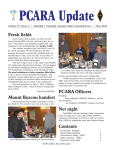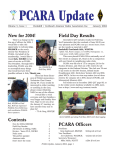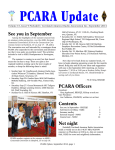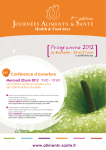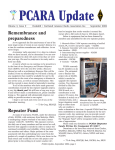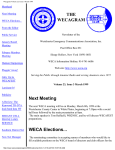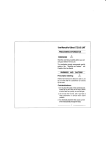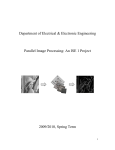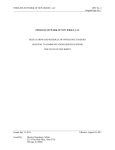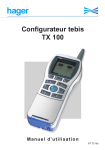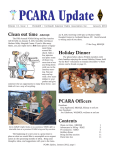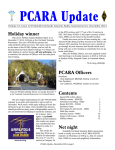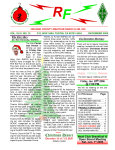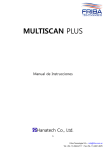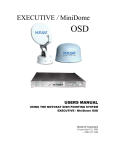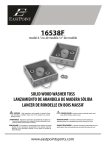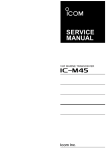Download PCARA Update March 2009
Transcript
PCARA Update Volume 10, Issue 3 Peekskill / Cortlandt Amateur Radio Association Inc. Consider conversion Ever wonder what happens to old commercial grade radio equipment? Something that was “state of the art” at one time becomes available for a fraction of its original cost on-line or at hamfests. At our April 5th meeting, Bob, N2CBH will be demonstrating how to repurpose rock-bound legacy commercial gear for amateur use. Bob will show us how to convert VHF-Hi and UHF HTs to amateur service, through the use of new crystals and a couple of tweaks. This could be developed into a club project of modifying a bunch of surplus commercial HTs and mobile radios to amateur use for emergency preparedness. Let’s talk! PCARA has taken a club table at the Orange County Amateur Radio Club Hamfest, on Saturday March 28, 2009 at the Town of Wallkill Community Center, in Middletown, NY. For further details visit the OCARC website at http://www.ocarc-ny.org/. Take this opportunity to get a jump on your shack’s Spring cleaning! Make room for all the new gear you’ll be getting as a result of the windfall from the 2009 Economic Stimulus Package! Bring along any stuff that you’re interested in selling and put it on the club table. March 2009 Our next meeting is March 1, 2009 at 3:00 PM at Hudson Valley Hospital Center. As always, ALL are welcome! I look forward to seeing each of you there. - 73 de Greg, KB2CQE Well done Joe Joe WA2MCR just received this certificate from CQ Magazine for the 2008 World Wide 160 Meter DX Contest, where Joe won “1st place single operator low power SSB New York, #12 United States, #1 2nd area.” PCARA Officers President: Greg Appleyard, KB2CQE, kb2cqe at arrl.net Vice President: Joe Calabrese, WA2MCR; wa2mcr at arrl.net Contents Special conversion edition! Consider conversion - KB2CQE Adventures in DXing - N2KZ Uniden conversion - NM9J If you manage to sell some of your stuff, all we ask is Quick Icom repair that you consider donating a couple of dollars to help WorldRadio online offset the cost of the table. Stamps jump up PCARA Update, March 2009, page 1 Bob N2CBH, Joe WA2MCR and Ray W2CH in conversation at the club table during the 2008 OCARC Hamfest. 1 2 5 6 7 7 Adventures in DXing – N2KZ DTV Conversion Confusion February 17, 2009 has come and gone and all the major television stations in the New York City area are still broadcasting analog signals. Due to a heavyhanded request by our new President, the grand switchoff of analog TV broadcasting has been delayed until June 12. Adding to the confusion, stations who are moving to new frequencies to broadcast digitally can apply for a further extension of their analog operations. With FCC approval, you may see ‘nightlight’ broadcasts telling viewers to switch to digital for a full month from June 13 through July 12. Will analog ever end? Channel 22 WWLP Springfield, MA switched to all-digital on February 17. Some broadcasters are not eligible for analog ‘nightlight’ operation. Local channels 7, 11 and 13 are going to be using their current analog frequencies for their new digital service. They won’t have old analog frequencies to transmit on! On the other hand, NYC channels 2, 4, 5 and 9 may be seen on their VHF frequencies into July. These ‘nightlight’ broadcasts will provide TV DXers with a unique one-time-only opportunity for E-skip viewing loaded with stations continually sending IDs making them very easy to identify. Did you ever think analog broadcasts would end with the best DX test of all time? ‘Random’ is a good word to describe what TV DXers might see. Some stations will be on the air and some won’t. The potential for catching new TV stations for your totals will be quite good. When the analog world finally ceases on July 12, all that will be left to see will be Canadians, Mexicans and rare stations from the Caribbean and South America. A few American low-powered analog stations will also still be operating. With the band suddenly empty, I can’t imagine what might be seen! It should be a new world! The end of low-band (56 to 88 MHz) television broadcasting will also bring new freedom to six meter amateur radio operations. Monster QRO operators on six meters will no longer worry about causing QRM to TV Channels 2 through 6 because no one will be watching anymore! As TV channels become abandoned, one by one, another type of activity is already being seen: pirate television! Members of the Worldwide TVFM DX Association are reporting clandestine broadcasts popping up in several markets across the U.S.A. Never underestimate the power of six meters! The potential for sporadic skip is always alive. E-skip, meteors, auroras and even the moon can bring in exotic catches. Listen to 50.098 MHz for CW, 50.110 MHz for overseas USB and 50.125 MHz for domestic USB DX. You never know when the band might light up. When it does, the activity is exciting! (I might reach 100 grid squares someday after all!) Determined FM Hobbyist Dobbs Ferry lawyer Marc Sophos has been trying to be a self-sustaining FM broadcaster since his high school days. He started his quest as a teenager by providing audio for cable TV public access channels and tinkering with Part 15 home broadcast kits. Marc built his own complete automated broadcast facility in his attic bedroom while he worked at a variety of metro area broadcast stations for experience and sustenance. Years of saving his pennies, fund-raising and dealmaking culminated in 1991 when Marc finally was granted an official FCC broadcast license for a noncommercial station based in Ossining, New York. Marc spent long hours and all his money to build an impressive broadcast studio on the second floor of an old office building in Ossining. Without tower space for his two-bay Shively FM antenna, he mounted it on the roof of the studio building. This became a fatal flaw! The building also housed a music school and his FM signals began creating havoc with guitar amps and radios in nearby local stores. It was a sad retreat when Marc had to disassemble all his work in the office building. He found compromise in a new arrangement: The WDFH antenna was moved to a new higher location up atop the hills of Ossining. Marc built a self-contained automation system right at the transmitter tower and got himself back on the air. The higher location meant that he had to reduce his power to maintain his former coverage area to gain FCC approval. Unfortunately, his lowpower broadcasts were hard to hear at any distance from his antenna due to close spacing with other stations on 90.3 MHz. For several years, Marc received a great boost PCARA Update, March 2009, page 2 working with Mercy College. Marc provided his license and transmission equipment. Mercy provided studio space and legions of broadcast students. The two parties worked hand-in-hand to create memorable community programming. This arrangement came to an end and Marc had to revert to another scaled-back operation. The clouds have now cleared again and Marc is enjoying new sunlight. WDFH was granted approval to move their antenna from Ossining down to Pleasantville and raise power to 53 watts. This new central location and much stronger signal now provides a wide coverage area serving a large portion of Westchester County. WDFH’s local-oriented programming is eclectic and original, produced entirely by FCC service area for WDFH, 90.3MHz FM. volunteers. If you are looking for something new and very different to listen to, WDFH might become your New Year’s gift. For more information, look at http:// www.wdfh.org or tune in to 90.3 FM. The little station once known as the voice of Dobbs Ferry High School is now the home of America’s most Determined FM Hobbyist! AT Sprint II Last month, I mentioned that I had begun experimentation with another QRP kit. This time, it was an AT Sprint II designed by Steve Weber KD1JV. This selfcontained battery powered four band transceiver is an extraordinary concise lightweight design specifically intended for backpackers and mountain toppers. Powered by AAA batteries, the unit weighs nearly nothing. The ATS II is capable of operating on 20, 30, 40 and 80 meters CW and features a tight band pass filter of about 500 Hz and a built-in keyer for a CW paddle. It is quite a rig. The unit is squeezed into a plastic box whose halves slide together. This allows for easy battery changing and band switching. Your operating band is determined by exchanging small rectangular boards that slide into two sockets on the main board. The ATS II produces a hefty signal of about five watts with minimal current draw. I found a few issues with this transceiver. You must be very careful exchanging band modules to avoid the AT Sprint II CW transceiver. horror of gray smoke! Align your pins exactly or bear the consequences! I found the band filter very tight for casual use. Unless a replying station is close to your frequency you simply won’t hear them! There is a provision for RIT, but you must remember to cancel its operation before you move on to another station. Frequency adjustment, sending speed and frequency readout are all achieved by manipulating four delicate-looking red pushbuttons that stick out through the plastic box. This seemed fragile to me. To move up in frequency, you would toggle one switch then use another switch to toggle down in frequency. It would have been nicer if this operation were consolidated into one switch. Navigation of functions takes a little getting used to. Again, by manipulating the onboard switches, you can change frequency and have it read back to you in Morse Code; you can change the speed of your CW paddle and even record a message or put the unit into beacon mode repeating a message time and again. Each one of these features is reached by holding down a button and waiting for the correct prompt to be heard through your headphones in a sequence. I found myself often turning the rig on and off just to get back to the default frequencies or state of operation. The ATS II is obviously geared for advanced CW operators with a flair for the outdoors. It is reminiscent of Dave Benson’s Small Wonder Labs series of rigs but marketed and packaged in an entirely different way. As a more casual operator, I prefer Dave’s SWL series but you certainly have to admire Steve’s compact and light design. The ATS II has now been refined with an entirely new model. Check out all of Steve’s work at: http://kd1jv.qrpradio.com/. Until next month, best of 73s and dit dit de N2KZ ‘The Old Goat.’ PCARA Update, March 2009, page 3 Uniden conversion A real bargain This story begins with the PCARA bring and buy auction in January. Bob, N2CBH had brought a bunch of commercial radiotelephone equipment to the auction and I was attracted to a Uniden UHF transceiver. A little online research revealed that Bob’s AMU 250 was a 25 watt mobile transceiver covering the commercial UHF band of 450-470 MHz. Next time I met Bob, the radio changed hands for a very reasonable sum. Uniden AMU 250 UHF FM transceiver as received from Bob, N2CBH. Questions of conversion The obvious course of action was to convert the Uniden down to the 440-450 MHz amateur FM band. Fortunately, Bob had handed over a collection of documents related to the radio, including the “Uniden Service Manual AMU 250”, the “Programming Instructions AMU 250” and “Preliminary Service Information AMU 250”. This group of documents was probably worth a lot more than the radio – without them, no conversion would have been possible. A quick check inside the radio revealed that it was the deluxe 8-channel model. Although the radio is synthesized, it dates back to 1982 and does not have any high-tech microprocessors or a fancy display. Instead, the channel programming is ‘stored’ in a diode matrix. Each transmit and receive channel has a set of 16 diodes in a SIL package. Diodes are cut for a logical “1” or left connected to channel-ground for a logical “0”. These diode-arrays are soldered onto a pair of circuit cards that fit into edge connectors on the transceiver’s main circuit board. Rotating the channel switch causes the common cathode line of the appropriate diode array to be grounded and the binary data is then made available to the synthesizer’s divider inputs. The phase lock loop frequency synthesizer is based on a Motorola MC145152P integrated circuit. I had some experience with this type of circuitry back in 1983 at Bury Radio Society in England where we had been modifying UK 27 MHz FM CB equipment for 29 MHz FM. Some of the inexpensive CB radios employed the Motorola MC145106 IC, and shifting the frequency was a matter of modifying the synthesizer’s binary inputs, retuning the voltage-controlled oscillator and repeaking the RF circuits. We want information, information! Modifying the Uniden radio followed a very similar pattern. The first requirement was to find a data sheet for the Motorola frequency synthesizer chip – this was available from Freescale Semiconductor’s web site, http://www.freescale.com. From the data sheet, I learned that the MC145152 is programmed by sixteen parallel inputs for the N and A counters. The ÷N range is from 3 to 1023 and the ÷A range is from 0 to 63. The MC145152 is designed to drive an external prescaler, extending its frequency range from a few megahertz into the VHF and UHF spectrum. A formula is provided that relates the total divide value NT to the synthesizer input frequencies: …where N is the number programmed into the ÷N counter, A is the number programmed into the ÷A counter and P is the divide ratio of the prescaler. Here is a sample calculation for the Uniden AMU 250 operating on a transmit frequency of 450.0125, with its in-loop oscillator on 320 MHz and a prescaler divide ratio (P) of 40: Frequency into prescaler = 450.0125 – in-loop oscillator, 320.000 MHz = 130.0125 MHz so NT = 130.0125 MHz / 0.0125 MHz = 10401 = (260 × 40) + 1 PCARA Update, March 2009, page 4 For N=260 and A=1 the binary pattern for the phase lock loop’s ÷N and ÷A inputs is as follows: 8 ÷N 0 5 ÷A 0 100000100 000001 …where a “1” means the diode in that position is cut and “0” means the diode remains in place. Would it work? My guess was that all that was needed to convert the Uniden down to 440 MHz would be to change the patterns in the diode arrays then re-peak the tuned circuits. The first thing to do was to draw up a table showing the binary patterns needed to cover the amateur band. In the 29 MHz FM CB conversions, I had written a little BASIC program to do this job and ran it on my Commodore PET, with output on a dot matrix printer. A quarter century later, we have more powerful tools available, and I prepared the new table of binary patterns for 440–450 MHz using Microsoft Excel. For an initial test, I chose a transmit frequency from the table that would need as few diodes as possible: 8 ÷N 0 5 ÷A 0 TX 447.8750 MHz 011111111 011110 TX 447.8875 MHz 011111111 011111 « TX 447.9000 MHz 011111111 100000 The diagram shows how one of the 16-diode arrays would be cut (‘x’) for a transmit frequency of 447.8875 MHz: Inside the AMU 250. The two channel boards containing the diode arrays for frequency programming are indicated by white arrows. More useful frequencies Having proved the point that the radio would tune down to 440 MHz, it was time to program some useful frequencies into it, using the diode arrays. The first circuit board already had four diode arrays soldered on, and I took a careful look at whether they could be reused. I was trying to change as few of the diodes as possible. Here’s how I reprogrammed the first channel for the KB2CQE repeater: 8 ÷N 0 5 ÷A 0 Channel 1 RX 463.925 MHz 011110101 000010 change to RX 449.925 MHz 011011001 000010 Channel 1 TX 468.925 MHz 100101001 change to TX 444.925 MHz 011111001 Common-cathode diode array as used in the AMU 250. This particular frequency, 447.8875 MHz, only needs two diodes in positions N8 and A5 to program the radio. I tack-soldered the two diodes onto an empty channel position on the circuit board, connected the transceiver to a dummy load and switched on. The Service Manual provides instructions for adjusting the voltage-controlled oscillator (VCO) – this was simply a matter of adjusting a trimmer capacitor inside the VCO shield cover while monitoring the voltage on a nearby test-point. I had already checked the various test voltages while the radio was operating on one of the commercial channels, and it did not take long to adjust to the correct value on 447.8875 MHz. This was followed by peaking of the transmitter’s RF circuitry according to the service manual. In a short time, RF output power began to appear on the power meter and the red “TX” LED lit up. The transmitter could easily supply 25 watts on this new frequency. 100010 100010 Only three changes were needed on the first diode array and only four on the second, shown above in bold. Sounds pretty simple! But it was more complicated in practice. First I had to completely unsolder the two 18-pin SIL packages from the circuit board, using HA047 16-diode array from Uniden AMU 250. my trusty solder sucker. The diode legs then had to be folded out of the way or rewired to a previously cut position. Finally, each diode array had to be soldered back onto the circuit board again. It was evident that I wasn’t the first person to do this, as the circuit board showed signs of previous channel changes, with tracks lifting off the substrate and the board warping with the heat. There is no wiggle-room between the SIL pack- PCARA Update, March 2009, page 5 ages, everything is packed together just as tightly as possible. After a couple of tries, the two diode arrays were reprogrammed and soldered into place. I repeated the RF alignment, obtaining good power output on 444.925 MHz. However, operation through the KB2CQE repeater requires one more thing, a transmit PL tone of 179.9Hz. This particular Uniden radio features an 8channel CTCSS tone generator, with a separate trimpot for each channel. I had to reconnect a wire link, then adjust the first trimpot for the correct PL frequency. Shortly afterwards, I was able to bring up the repeater on 449.925 MHz and had a contact with the man himself, Greg, KB2CQE. I reprogrammed the next channel for Bob’s repeater on 448.725 MHz, with a 107.2 Hz PL tone. This time, I chose two diode arrays that had originally been programmed for a simplex transmit and receive frequency of 463.925 MHz. This needed a lot more diodes to be changed, and it took a while to get all the connections soldered. But after a few corrections, the radio came up on the correct frequency. Uniden AMU 250 after conversion to 440 MHz, with new panel lamp in place. As a finishing touch, I decided to replace the panel lamp that illuminates the back of the channel indicator. The type of bulb used is a small 12 volt pea lamp with wire leads. I managed to find a suitable bulb at Radio Shack, disguised as a red snap-in “12 VDC Lamp Assembly”, part number 272-0332. Pulling the plastic assembly apart revealed a suitable wire-ended bulb within. Nostalgia time I must say that programming radios with a diode matrix like the Uniden’s is not as easy as I remembered. I must have been looking back at my past experiences with older radios through rose-tinted spectacles. If there was a need to change frequencies again, or add more channels, quite a lot of work is involved. The 18pin diode arrays are no longer available, and the multichannel circuit boards are showing distinct signs of wear and tear. I think this radio will be staying on our two local UHF repeaters for quite a while. - NM9J Quick Icom repair Completing the Uniden conversion gave me a chance to repair my trusty old Icom IC-3200A transceiver. This Icom was my first mobile radio purchased in the U.S.A., costing $479 back in March 1986. This large sum bought a 25 watt, 2 meter/440 MHz oneband-at-a-time transceiver, with 10 memory channels. At the time, Icom radios stood out from the competition because they included the PL-encode unit. This was an optional extra for other manufacturers. The radio was mounted in two different vehicles over a period of thirteen years, after which it saw service indoors for monitoring the local UHF repeaters. The LCD panel was backlit with three incandescent lamps, and over a period of years, these lamps failed one by one. The third lamp burned out a few weeks ago, leaving the LCD panel completely black. The panel could be read in daylight, but at night I had to Icom IC-3200A with unlit liquid crystal shine a flashdisplay. Is it switched on? light to check the frequency. My first try at disassembling the front panel to reach the lamps was not encouraging. After removing the top and bottom covers from the radio, it was clear that behind the front panel were two circuit boards, “Logic A” and “Logic B”, with a large collection of multiway cables connecting the top Logic B board to the main transceiver body. The Logic B board also held a lithium coin cell that backed up the CPU memory. Disconnecting this battery would likely wipe out all the memories. I put the radio back together again while I considered the problem for a few more weeks. Before the next attempt, I carried out some online research and found a copy of the IC-3200A/E Service Manual in PDF format at “The Repeater Builder’s Technical Information Page”, http://www.repeaterbuilder.com. This is an excellent site for all things related to repeaters and amateur FM activities. Remember to check here when you have any technical questions about surplus FM equipment. The Icom Service Manual contained an exploded diagram entitled “Front Panel Disassembly” and a drawing of the Logic A circuit board layout. These pictures suggested it might be possible to reach the PCARA Update, March 2009, page 6 front panel lamps by removing items from the front of the radio, rather than by starting from the rear of the front panel and removing layer after layer of circuit boards. The diagrams were correct! The order of removal was as follows… disconnect power from the radio, remove top and bottom covers, remove four screws holding plastic front panel to metal sub-chassis. Pull off three front panel knobs and unscrew the front bezel off the microphone connector. Pull the plastic front panel straight off the radio – taking care that the eleven push buttons don’t fall out of the plastic panel. This reveals the liquid crystal display mounted on the front-facing side of the Logic A board. (See photo.) IC-3200A with plastic front panel removed. By removing a black rubber cover and straightening three metal clips, the entire LCD assembly can be lifted straight off the circuit board, revealing three green-colored dial lamps (DS1, DS2 and DS3) mounted directly on the Logic A circuit board. new bulbs is critical because they have to fit into three cutouts in the plastic light guide that surrounds the LCD assembly. Refitting the LCD assembly and powering up the radio proved that the new lamps were now lit and the liquid crystal display was still functioning correctly. The front panel was reassembled, then the top and bottom covers were replaced. The radio was as good as Icom IC-3200A afer LCD backight new! was repaired. In these times of economic uncertainty, it is well worth conserving resources by keeping an older radio running for a while longer. There are a few features missing from these older radios – they might not have many memories, but they also have no noisy cooling fan, no complicated menus to set up and no wide-band front end, wide open to cross-modulation. A good bargain all round. - NM9J WorldRadio online The first two issues of WorldRadio Online — February and March 2009 — are now posted on CQ Magazine’s web site. To download and view the issues, go to the CQ home page at http://www.cq-amateurradio.com and click on the “World Radio Online” box. These are large Acrobat PDF files, 12-13 MB in size. After removing the LCD assembly, the Logic A circuit board is visible, with three green backlight lamps (first one arrowed). New Lamps for Old These lamps are specified in the Icom parts list as “HRS-7219A-G40”, which is a 12 volt ‘grain of wheat’ bulb with twin wire connections. I found an equivalent at Radio Shack, part number 272-1092, a #7219 Micro Lamp rated at 12 volts, 60 milliamps, with a wire terminal base. The lamps on the Icom circuit board were covered with thin, green silicone rubber caps. The transparent caps change the display color from amber to green. I transferred the rubber caps to the new bulbs, cut the wire leads to the old bulbs then soldered the new bulbs in their place on the circuit board. Positioning of the Stamps jump up The price of a first class stamp will increase 2 cents from 42 cents to 44 cents on Monday May 11. “Forever Stamps” intended for mailing 1-ounce letters at any time, can still be used after the price change, without the need for any additional postage. While the 44 cent stamp will be sufficient for a one ounce letter, the cost of a two ounce letter will also increase by 2 cents to 61 cents. Postcards will increase by 1 cent to 28 cents. The International rate increases from 94 to 98 cents for a 1-ounce air-mail letter (Canada and Mexico are less.) Remember to keep your QSL Manager stocked with envelopes having sufficient postage. PCARA Update, March 2009, page 7 Peekskill / Cortlandt Amateur Radio Association PCARA Calendar Sun Feb 1: PCARA meeting. Hudson Valley Hospital Center, 3:00 p.m. Mail: PCARA, PO Box 146, Crompond, NY 10517 E-Mail: [email protected] Web site: http://www.pcara.org Hamfests PCARA Update Editor: Malcolm Pritchard, NM9J E-mail: NM9J @ arrl.net Newsletter contributions are always very welcome! Archive: http://home.computer.net/~pcara/newslett.htm PCARA Information PCARA is a Non-Profit Community Service Organization. PCARA meetings take place the first Sunday of each month* at 3:00 p.m. in Dining Room B of the Hudson Valley Hospital Center, Route 202, Cortlandt Manor, NY 10567. Drive round behind the main hospital building and enter from the rear (look for the oxygen tanks). Talk-in is available on the 146.67 repeater. *Apart from holidays. PCARA Repeaters W2NYW: 146.67 MHz -0.6, PL 156.7Hz KB2CQE: 449.925MHz -5.0, PL 179.9Hz (IRLP node: 4214) N2CBH: 448.725MHz -5.0, PL 107.2Hz Sun Mar 8: LIMARC Long Island Hamfair & Electronics Show, Levittown Hall, Hicksville, NY. 9:00 a.m. Sat Mar 28: Orange County ARC Spring Hamfest, Town of Walkill Community Center, 2 Wes Warren Drive, Middletown, NY. 8:00 a.m. (Club Table) Sat Apr 4: Splitrock ARA Hamfest, Roxbury Senior Center, 72 Eyland Ave, Succasunna, NJ. 8:00 a.m. Sun Apr 26: Mt Beacon ARC Hamfest, Tymor Park, LaGrangeville, NY. 9:00 a.m. (Club Table) VE Test Sessions Mar 1: Yonkers ARC, Yonkers PD, 1st Precinct, E Grassy Sprain Rd, 8:30 a.m. Contact D. Calabrese, (914) 667-0587. Mar 12: WECA, Westchester Cnty Fire Trg Center, 4 Dana Rd., Valhalla, NY. 7:00 p.m. Contact Stanley Rothman (914) 8313258. Mar 16: Columbia Univ VE Team, 2960 Broadway, 115 Havemeyer Hall, New York NY. 6:30 p.m. Contact Alan Croswell, (212) 854-3754. Mar 20: Bergen ARA, Westwood Regional HS, 701 Ridgewood Rd, Washington Twnshp, NJ. 7:00 p.m. Contact Donald C Younger, (201) 265-6583. Mar 28: Orange County ARC, Town of Wallkill Community Center, 2 Wes Warren Rd, Middletown NY. 8:30 a.m. Apr 25: PEARL, Mahopac Public Library, 668 Rt 6, Mahopac NY. 10:00 a.m. Contact NM9J. Peekskill / Cortlandt Amateur Radio Association Inc. PO Box 146 Crompond, NY 10517 PCARA Update, March 2009, page 8








